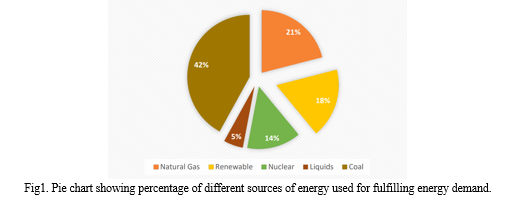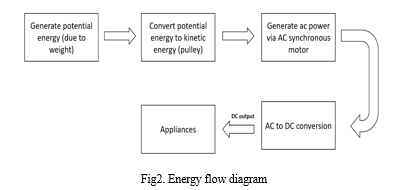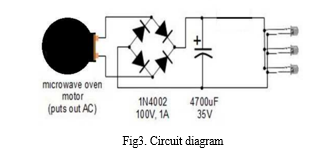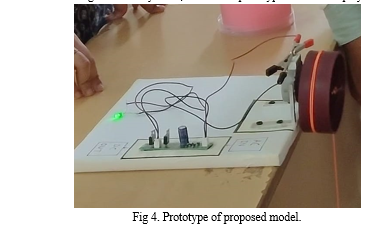Ijraset Journal For Research in Applied Science and Engineering Technology
- Home / Ijraset
- On This Page
- Abstract
- Introduction
- Conclusion
- References
- Copyright
Power Generation Using Gravity
Authors: Dr D. Srinivasulu Reddy, T. V. Sravanthi, S. Nasreen, V. Jayasree, V. Rishi Kesava Reddy, T. Harikrishna
DOI Link: https://doi.org/10.22214/ijraset.2024.60276
Certificate: View Certificate
Abstract
In recent times due to effect of pollution and global warming there is a need for generating power from renewable sources. The reason for generating power using gravity is that it is available all over the Earth, abundant and consistent too. This method utilizes the force of gravity to drive mechanical systems, such as falling weights or water, which in turn generate electricity. Due to the development and modernization the electricity demand is increasing at high extent. To fulfil this demand globally which is without any harmful effect on environment is possible by using gravity power generation. In recent times due to effects of pollution there is a need for generating power from renewable sources. In this project, the gravitational energy of a heavy particle is converted to the electrical energy. When the heavy particle falls down from a higher altitude to a lower one, its potential energy is converted into the kinetic energy. Then this energy is converted to electricity by using a synchronous motor. When increasing the altitude of the load, the lighting time increases. If load increases, power production also increases.
Introduction
I. INTRODUCTION
During the last few decades power requirement has reached to high extent, for various purposes, due to ever increasing population, development and modernization. The concept of power generation using gravity is rooted in the principle of energy conversion. Potential energy, which is the energy stored in an object due to its position relative to other objects, is a key component of this process. When an object is lifted to a certain height, it gains potential energy because of its elevated position. This potential energy can be released when the object falls under the influence of gravity, converting it into kinetic energy, which is the energy of motion. By capturing and harnessing this kinetic energy, we can generate electricity to power homes, businesses, and industries.
Power generation using gravity is an innovative approach that taps into the natural force of gravity to produce electricity. This method harnesses the potential energy stored in elevated masses and converts it into kinetic energy [1], which can then be captured and transformed into usable electrical power. By leveraging gravity, one of the fundamental forces of nature, this approach offers a sustainable and renewable energy solution that has the potential to contribute significantly to the global transition towards cleaner and more environmentally friendly sources of power. There are several methods by which power generation using gravity can be implemented. One common approach is through the use of gravitational potential energy in water bodies, such as rivers or streams. By constructing hydroelectric [2] dams or installations, we can create reservoirs of water at elevated heights. When water is released from these reservoirs, it flows downhill, turning turbines and generating electricity through the conversion of gravitational potential energy into kinetic energy. This method of hydroelectric power generation has been widely adopted around the world and has become a significant source of renewable energy. The below pie chart [3] shows the percentage of usage of renewable sources which is very low compared to other sources coal and oil.

In this work AC synchronous motor is used to generate electricity, when an object of certain weight is made to fall from a certain height which is attached to a rope and the rope is made to rotate the pulley in such a way that the shaft of the AC synchronous motor is rotated.
In this process electricity is produced at the terminals of the synchronous motor. The generated electricity is ac and it is then further converted into dc and made used according to our required applications. Energy conversion is based on law of conservation of energy [4], it states that, Energy cannot be created or destroyed, to can only change it forms, from one form to another.
II. LITERATURE REVIEW
Perpetual Motion Machine generates electrical power: Generation of Power using Perpetual Motion, the basic concept of perpetual motion means a motion that continuous indefinitely without any external energy source. Perpetual motion using gravitational energy which will be converted into kinetic energy. After that, the kinetic energy will be converted to electrical energy using power generator.[5]
Gravity Lights: A lamp design using renewable energy that can be used throughout the day without the slightest cost in its use. One of the renewable energies available on earth that can be used to replace petromax lamps is energy that comes from the gravitational force of the earth. [6]
Hydroelectric Energy: Hydropower is electricity generated using the energy of moving water. Rain or melted snow, usually originating in hills and mountains, create streams and rivers that eventually run to the ocean.[7]
Wind Energy: Wind energy has been the renewable power most used up to now, mainly by means of onshore installations. This selective progress can be explained due to both the high wind resource availability and the high technology maturity of maturity of wind energy in comparison with the rest of renewable energies.[8]
Solar Energy: Solar energy reaches the earth in various forms like heat and light. As this energy travels, majority of its portion is lost by scattering, reflection and absorption by clouds. Studies revealed that global energy demand can be fulfilled by using solar energy satisfactorily as it is abundant in nature and freely available source of energy with no cost.[9]
III. METHODOLOGY
The main renewable sources we currently use are Solar energy, Wind energy, Hydroelectric energy (tidal energy). Furthermore, the cost, and availability and durability of solar pannels decays the effectiveness of the power generated using solar energy. To address these, issues, this work came up with another abundantly available renewable source named gravity. Gravity can also be used as a source of renewable energy, this work demonstrated this at its best. Power generation using gravity is cost efficient than solar power generation.
The energy flow and the working of this prototype is given in the below flow chart:

Initially, the potential energy due to weight is converted into kinetic energy due to the gravitational pull towards Earth. This motion is made to rotate the pulley which is connected to AC synchronous motor, due to its rotations. The change in the flux of the coils inside the AC synchronous motor generates electricity of order 100v. this generated ac power in then converted to dc power using bridge rectifier connected to voltage regulator to generate a constant voltage of desired requirements. This generated dc power is utilized to run electric/electronic appliances, moreover the excess energy is further stored in lithium-ion rechargeable battery.
A. AC To DC Conversion
AC to DC conversion is the part where the generated AC power from the ac synchronous motor is converted to DC power, this is made by using a bridge rectifier connected to a capacitor, Bridge rectifier filters the positive half cycles of the AC power and doesn’t allow the negative half cycles to pass through it and a capacitor is used to smoothen the DC output, the circuit diagram of the Bridge rectifier is and the system is given below:

B. Working Principle
The main source to generate electricity in this project is gravity, any object which is placed in free space faces a gravitational pull towards earth. When a load is attached to the string, due to the influence of gravity on the load it is made to rotate the pully and rotate the shaft of the ac synchronous motor, which in result generates a voltage of around 90-100V which is an alternating current, which is unstable, then this alternating current is converted into direct current using bridge rectifier and voltage regulator to maintain a constant voltage, the output voltage is around 2.2-2.3 volts and 0.5 mA current when the load is 500g. we get a voltage of 2.4 – 5 volts and 3 mA current when the load is 1000g.
IV. RESULT & DISCUSSIONS
In this work, two loads of weight 500g and 1000g are used to access the model. If, the weight increases the pulley rotates faster and makes the load to reach ground quickly, as a result of gravity. The speed of pulley in turn results in large number of rotations in synchronous motor and produce more energy. The output values of voltage and current in AC and DC are listed Table 1, when the loads are 500 and 1000g respectively. (Where g=9.8m/s2)
Table 1: Out Voltage generated with respect to different load conditions
|
Load |
Alternating current |
Direct current |
|
500g |
(98-105) V |
(2.2-2.3) V&0.5 mA |
|
1000g |
(127-134) V |
(2.4-5) V & 3 mA |
Moreover, the prototype is evaluated under different conditions by varying the parameters such as string length and gravity (by moving to different geographic location).
Firstly, starting with varying gravity, by considering the fact that gravity varies in different areas due to the change in the altitude of the surface and hence altered the generated power. The same is mathematically explained as follows:
The gravitational force on a small mass m some distance R from the centre of a large spherical mass M is given by
|F| = (GMm)/R2
Accordingly, the force due to gravity is inversely proportional to the square of the distance between the two masses the resultant output is presented in Table 2.
Table 2: Output Power generated with varying geographic locations
|
Load |
Alternating current |
Direct current |
|
500g |
(97-103) V |
2.2 V &0.45 mA |
|
1000g |
(122-129) V |
(2.5-4) V & 2.8 mA |
Table2. OUTPUT VOLTAGE AND CURRENT AT HIGH ALTITUDE
Similarly, the module is tested by varying the string length, initially the length of the string was 1m, now the length is 2m the attained results are placed in Table 3.
Table 3: Output Power generated with varying String Length
|
Load |
Alternating current |
Direct current |
|
500g |
(97-115) V |
(2.2-4) V & 1mA |
|
1000g |
(126-139) V |
(2.2-5) V & 5mA |
Herein, the generated AC and DC output is utilized to powerup electrical and electronic devices/appliances moreover the excess energy is stored in a lithium-ion rechargeable battery. Also, the overall prototype model is displayed in Figure 4.

Conclusion
In this work, earth’s gravity to generate energy. Initially the potential energy due to gravity is converted to kinetic energy and then this kinetic energy is converted to mechanical energy and then it is converted to electrical energy. From the law of conservation of energy, Energy cannot be created or destroyed it can be transformed from one form to another. By increasing the usage of sustainable energy sources, clean energy which decreases pollution. In this way available gravitational energy can be utilized.
References
[1] Kinetic energy | Definition, Formula, Units, Examples, & Facts. (2024, March 7). Encyclopedia Britannica. https://www.britannica.com/science/kinetic-energy [2] Potential Energy - Hydropower. (2024, April 8). https://www.engineeringtoolbox.com/potential-energy-d_1218.html [3] Elavarasan, R. M. (2019, February 6). The Motivation for Renewable Energy and its Comparison with Other Energy Sources: A Review. European Journal of Sustainable Development Research, 3(1). https://doi.org/10.20897/ejosdr/4005 [4] Law of conservation of energy - Energy Education. (n.d.). https://energyeducation.ca/encyclopedia/Law_of_conservation_of_energy [5] Hidayat, M. N., Chairandy, S. P., & Ronilaya, F. (2021, March 1). A review on how a Perpetual Motion Machine generates electrical power. IOP Conference Series: Materials Science and Engineering, 1098(4), 042063. https://doi.org/10.1088/1757-899x/1098/4/042063 [6] Manik, C. T. S. (2019, December 29). Tool Demonstration Lamp Gravity (Gravity Lights). Journal of Science Technology (JoSTec), 1(1), 15–20. https://doi.org/10.55299/jostec.v1i1.47 [7] Mohsen, M., Bagher, A. M., Reza, B. M., Vahid, M. M. A., & Mahdi, T. (2015, December 1). Comparing the generation of electricity from renewable and non-renewable energy sources in Iran and the world: now and future. World Journal of Engineering, 12(6), 627–638. https://doi.org/10.1260/1708-5284.12.6.627 [8] Esteban, M. D., Diez, J. J., López, J. S., & Negro, V. (2011, February). Why offshore wind energy? Renewable Energy, 36(2), 444–450. https://doi.org/10.1016/j.renene.2010.07.009 [9] Kannan, N., & Vakeesan, D. (2016, September). Solar energy for future world: - A review. Renewable and Sustainable Energy Reviews, 62, 1092–1105. https://doi.org/10.1016/j.rser.2016.05.022
Copyright
Copyright © 2024 Dr D. Srinivasulu Reddy, T. V. Sravanthi, S. Nasreen, V. Jayasree, V. Rishi Kesava Reddy, T. Harikrishna. This is an open access article distributed under the Creative Commons Attribution License, which permits unrestricted use, distribution, and reproduction in any medium, provided the original work is properly cited.

Download Paper
Paper Id : IJRASET60276
Publish Date : 2024-04-13
ISSN : 2321-9653
Publisher Name : IJRASET
DOI Link : Click Here
 Submit Paper Online
Submit Paper Online

